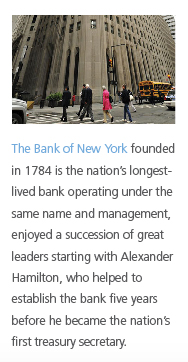By Robert E. Wright and Richard Sylla
With the evolution of banking over the years, many banks have flourished and declined in America. It has piqued our curiosity what happened to them, did they get absorbed by larger banks or go bankrupt? Robert Wright and Richard Sylla discuss in this article the development of banking in the US and try to determine where all the American Banks have gone.
In 1789 when George Washington took office as the first US president, the country had three banks, one each in Philadelphia, New York, and Boston. At the peak number in 1922, there were about 30 thousand independent US banks. As recently as 1990, more than 15 thousand banks were insured by the Federal Deposit Insurance Corporation (FDIC). A quarter century later there are about 6 thousand independent banks. Thus, in less than a century, the US has lost four-fifths of its banks.
Contrary to common perceptions of reckless banking, most of America’s defunct banks exited via merger rather than outright failure and bankruptcy. True, that is partly because the FDIC, one of the regulators of almost all US-based banks since the 1930s, often aids failing banks by arranging mergers with stronger institutions. Most merger activity, however, stems from the age-old affinity of American banks for increasing their size and decreasing their competition whenever and however possible. The common perception of the fragility of the US banking system, however, is not entirely wrong: over the course of US history, 23 thousand banks failed, most in gobs associated with the infamous financial panics of the nineteenth century and the even more infamous banking crises of the Great Depression.
The disappearance of so many US banks, mostly by being absorbed into larger institutions, prompted us to write Genealogy of American Finance (2015). The book contains short, illustrated histories of the 50 largest financial holding companies recently operating in the United States, along with their “family trees”, that is, charts showing all the predecessor institutions that were acquired or merged together to form the current behemoths. Often these charts are so large that they do not fit on the large-sized pages of our book, but thanks to modern information technologies, they can be accessed at the website of the Museum of American Finance, which sponsored the project.
Since Americans throughout the country’s history had distaste for concentrated power of any kind, especially concentrated financial power, it is striking to see how much financial concentration has occurred in recent decades. As recent as 1990, the ten largest US financial institutions held only about 10 percent of the country’s financial assets. Now the top 50 institutions featured in our study hold the great majority of those assets, and even within that grouping, the top ten — which includes such marquee names as JPMorgan Chase & Co, Bank of America, Citigroup, Wells Fargo, Goldman Sachs, Morgan Stanley, Bank of New York Mellon, and US Bancorp — had more than 70 percent of the entire group’s assets.
 US banks have succeeded or failed for three major reasons: chance, leadership, and banking system structure. Chance is the least interesting or important of the causes, playing a major role only at the margin where leadership and banking system structure have left institutions teetering on the edge of the precipice waiting only for the swirling wind to push them over or to save them from the abyss. Though most of the time, bad leaders drive their banks off the cliff while good ones keep their banks well clear of the lip, especially during panics.
US banks have succeeded or failed for three major reasons: chance, leadership, and banking system structure. Chance is the least interesting or important of the causes, playing a major role only at the margin where leadership and banking system structure have left institutions teetering on the edge of the precipice waiting only for the swirling wind to push them over or to save them from the abyss. Though most of the time, bad leaders drive their banks off the cliff while good ones keep their banks well clear of the lip, especially during panics.
Even good bankers will occasionally go too far. The best, though, understand the dangers that lurk in the shadows and know how to stop or turnaround. Consider, for example, the early leaders of GMAC (General Motors Acceptance Corporation, founded in 1919 and now in our top 50 as Ally Financial). Due to their foresight, GMAC’s loss ratio remained below one percent even during the Great Depression. They knew that the new breed of borrowers relied heavily on their automobiles so GMAC set loan-to-value just right, not so low as to discourage borrowing but high enough to give borrowers a sufficient incentive to make their payments. In the 2000s, however, GMAC’s leaders were not so astute and almost bankrupted the institution by “diversifying” into the doomed subprime mortgage market. When auto sales slumped following the financial crisis, GMAC received two bailouts: first, bank-holding company status, which gave it access to emergency loans from the Federal Reserve, and, second, Troubled Asset Relief Program (TARP) equity purchases. GMAC went over the cliff but instead of allowing it to crash and burn, the government threw up nets to keep it safe, more out of consideration for the health of its corporate parent than GMAC itself.
 American Express, founded in 1848 and in our top 50, has yet to rely on a government safety net but several times in its history it had two wheels off the edge of the cliff. Other times, however, the company has been compared to a granite cliff able to withstand even the most horrific financial whirlwind. During the banking panic of March 1933, for example, the government allowed American Express to remain open during President Franklin D. Roosevelt’s “bank holiday” that shuttered almost all banks, making it one of the few financial institutions to continue making payments during the forced hiatus.
American Express, founded in 1848 and in our top 50, has yet to rely on a government safety net but several times in its history it had two wheels off the edge of the cliff. Other times, however, the company has been compared to a granite cliff able to withstand even the most horrific financial whirlwind. During the banking panic of March 1933, for example, the government allowed American Express to remain open during President Franklin D. Roosevelt’s “bank holiday” that shuttered almost all banks, making it one of the few financial institutions to continue making payments during the forced hiatus.
The greatest bank leaders become icons whose spirits guide their institutions long after their passing. A. P. Giannini, long-time leader of Bank of America (one branch, but not the trunk, of the mighty tree that bears the same name today), started his bank in 1904 in San Francisco and received a big boost when the Great Earthquake of 1906 ruined the city and most of its financial infrastructure. In subsequent decades, he did what few other American banks at the time lawfully could do, grow large organically (i.e., by establishing de novo branches) and via merger (i.e., by buying other banks). He also successfully steered his bank during the worst of the Depression. When A.P. died in 1949, his bank was one of the largest banking institutions in the nation. His influence over the bank persisted in spirit until his daughter, the final member of his family involved in the leadership, became a non-voting director emeritus in 1970 and resigned from the board entirely in 1985 at the beginning of the bank’s three year slide into near oblivion. New leadership emerged to pull the bank not only to safety but to record profits and growth. In 1998, Bank of America was merged into NationsBank, with the combined entity keeping the storied Bank of America name. A decade later during the financial crisis, it acquired Merrill Lynch and with it a number of headaches that are gradually going away.
 The Bank of New York founded in 1784 is the nation’s longest-lived bank operating under the same name and management, enjoyed a succession of great leaders starting with Alexander Hamilton, who helped to establish the bank five years before he became the nation’s first treasury secretary. During the Great Depression, like the nation’s few other banks of undoubted credit and quality leadership, the Bank of New York found itself flooded with deposits in what economists now call a “flight to quality”. It merged with Mellon, another bank with a long history of quality leadership in 2007.
The Bank of New York founded in 1784 is the nation’s longest-lived bank operating under the same name and management, enjoyed a succession of great leaders starting with Alexander Hamilton, who helped to establish the bank five years before he became the nation’s first treasury secretary. During the Great Depression, like the nation’s few other banks of undoubted credit and quality leadership, the Bank of New York found itself flooded with deposits in what economists now call a “flight to quality”. It merged with Mellon, another bank with a long history of quality leadership in 2007.
Leaders are of course constrained by various forces — market, political, and regulatory. The best leaders predict and, to the extent possible, even steer changes in the constraints they face. But often they have to work within parameters they cannot affect, at least in the short term. The most important of those parameters is the structure of the overall banking system.
Until the last few decades, America’s banking structure was out of step with most of the leading nations of Europe and even neighboring Canada. Those countries for the past century or more have featured a relatively small number of large banks with extensive branch systems, in contrast with the United States with, until recently, its tens of thousands of independent banks, mostly small ones with only one office, so-called “unit banking”. This odd banking structure by world standards was inefficient in credit allocation, unstable, and despite the large numbers of banks, non-competitive. Yet it persisted for more than 150 years, from the early 19th century to the late 20th century. Why?
The answer appears to be that virtually from its inception more than two centuries ago, US banking was dominated by state rather than national interests. Until the 1860s the states chartered almost all the banks, and when the federal government began to charter so-called national banks in the 1860s, those banks were required to conform to state norms. They could not cross state lines. They could not in most cases have more than one office. This was a political outcome resulting from an alliance of small unit banks in every state with “populist” state political leaders who determined the banking laws. The unit banks wanted to be protected from the competition that might come from larger branch banks. The populist politicians feared the concentrated financial power that might come from large, branching banks and they wanted to have the political and financial support of the numerous unit bankers. So branch banking was forbidden in most states, and banks could not operate across state lines.
The old unit banker-populist political alliance began to be undermined in the 1970s when retail money market funds and cash management sweep accounts at securities brokers caused disintermediation, (i.e., bank depositors took their funds from banks and placed them with the capital market institutions of Wall Street). In the 1980s, regulators merged failing banks and savings and loan institutions into larger banks, even ones headquartered in other states. Finally in 1994, Congress passed a law allowing nationwide branch banking for the first time since it had been practiced by the ill-fated Banks of the United States early in the nation’s history.
These changes of recent decades allowed the emergence of the megabanks and gigantic bank holding companies we study in our book. The financial concentration they represent has made US banking perhaps more rational, and surely more like that of other nations. But it also has exacerbated the problem of banks that are “too big to fail”, and led to a host of new regulations to cope with that problem and make the financial system safer and less crisis-prone. We look forward to observing whether they will work.
About the Authors
 Dr. Robert E. Wright is the Nef Family Chair of Political Economy at Augustana University and the author or co-author of 17 books on US financial history and policy, including Genealogy of American Finance. He is also a member of the editorial board of Financial History, a quarterly magazine published by the Museum of American Finance, a Smithsonian affiliate located in the heart of Manhattan’s financial district.
Dr. Robert E. Wright is the Nef Family Chair of Political Economy at Augustana University and the author or co-author of 17 books on US financial history and policy, including Genealogy of American Finance. He is also a member of the editorial board of Financial History, a quarterly magazine published by the Museum of American Finance, a Smithsonian affiliate located in the heart of Manhattan’s financial district.
 Dr. Richard Sylla is Professor emeritus of Economics and was from 1990 to 2015 Henry Kaufman Professor of the History of Financial Institutions and Markets at New York University’s Stern School of Business. Since 2010 he has chaired the board of trustees of the Museum of American Finance.
Dr. Richard Sylla is Professor emeritus of Economics and was from 1990 to 2015 Henry Kaufman Professor of the History of Financial Institutions and Markets at New York University’s Stern School of Business. Since 2010 he has chaired the board of trustees of the Museum of American Finance.
































































